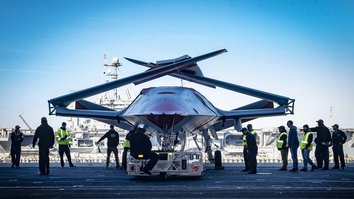As new threats emerge around the world, the F-35C Lightning II provides the US Navy with unmatched stealth capabilities and lethality from the sea, enabling it to operate in the most contested environments.
The world's first and only long-range stealth strike fighter designed exclusively to operate from the decks of aircraft carriers, the F-35C sets new standards in weapon system integration, lethality, maintainability, combat radius and payload.
The fighter will eventually be deployed with the US Navy's nuclear-powered aircraft carrier USS Gerald R. Ford, arguably making it the most powerful aircraft carrier in the world.
The F-35C is the naval variant of the F-35 Joint Strike Fighter, capable of conducting air-to-air, air-to-ground and electronic warfare missions.
![Two F-35Cs fly in formation during a training mission. [US Air Force]](/cnmi_ca/images/2023/04/13/41824-1880845-585_329.jpg)
Two F-35Cs fly in formation during a training mission. [US Air Force]
The aircraft is designed to be low-observable, which means that it can evade detection by enemy radar systems. This feature makes it an ideal platform for conducting stealthy missions deep inside enemy territory.
Its stealth capabilities are achieved through a combination of design features, such as a streamlined shape, internal weapons bays and radar-absorbent materials.
The aircraft's configuration, embedded sensors, internal fuel and weapons capacity, aligned edges and state-of-the-art manufacturing processes all contribute to its stealth performance, which enables pilots to evade enemy detection.
Its advanced sensors and avionics systems enable it to gather and process large amounts of information about the battlefield, and to detect and engage enemy targets at long ranges.
The wings and landing gear are specifically designed for catapult launches using the Electromagnetic Aircraft Launch System (EMALS), and the wingtips also fold to allow for more room on the carrier's deck.
The F-35C carries almost 10 tonnes of internal fuel, has a range of greater than 1,200 nautical miles (2,200km) and can reach speeds of Mach 1.6 (about 1,200 mph or 1,931km/hour) even with a full internal weapon load.
The engine is highly efficient, giving the aircraft a significant advantage in terms of fuel economy and operational range.
The F-35C can carry more than 2.6 tonnes of ordnance internally, or more than 10 tonnes of combined internal and external weapons in "beast mode".
This capability allows the aircraft increased lethality with additional external weapons when it no longer has to rely on its stealth for survivability.
One of the F-35C's most advanced weapons is the Joint Strike Missile (JSM), a long-range, anti-ship missile that can be launched from the aircraft's internal weapons bays.
The JSM is designed to defeat modern anti-ship defences and can engage targets at ranges of up to 150 nautical miles (277km). The missile is also highly manoeuvrable, allowing it to avoid enemy defences and strike its target with precision.
Advanced war-fighting and defensive systems
The F-35C is equipped with a range of advanced defensive systems, which enable it to survive in highly contested environments.
These systems include an electronic warfare suite, a radar warning receiver and a countermeasure system.
The aircraft also has the most advanced and comprehensive sensor suite of any fighter jet in history.
It is equipped with a Distributed Aperture System (DAS), which uses multiple sensors to provide the pilot with a 360-degree view of the battlefield. This enables the pilot to detect and engage enemy threats from all directions, enhancing the aircraft's survivability.
Unlike other sensors, DAS picks up targets without assistance from an external cue. Because the sensor is always staring simultaneously in every direction, an operator does not have to point it in the direction of a target to gain a track, according to Military Aerospace Electronics.
The F-35C is also equipped with an Active Electronically Scanned Arrays (AESA) fire control radar, a crucial component of the F-35 sensor suite. AESA radar puts F-35Cs far ahead of Russian Su-35 fighters, which rely on an older, less capable passive electronically scanned array (PESA) radar system.
Planes equipped with AESA radars are likely to be able to detect and engage an Su-35 beyond visual range (BVR) before it can react.
An advanced version of the AESA radar is currently under development, and will support all variants of the F-35, according to Northrop Grumman.
Other features of the F-35C include the Electro-Optical Targeting System (EOTS), which, according to Lockheed-Martin, "enhances F-35 pilots' situational awareness and allows aircrews to identify areas of interest, perform reconnaissance and precisely deliver laser and GPS [global positioning system]-guided weapons".
Another asset of the F-35C is the Helmet Mounted Display System, which empowers pilots to see everything in the battle space. The system gives pilots "an uninterrupted display of flight information and sensor data" and "tactical superiority–both day and night", according to Collins Aerospace.
The F-35C is designed to operate in a networked environment, so it can operate as part of a larger force -- including US and other allied aircraft -- and share information about enemy targets and threats in real time.

![An F-35C aboard aircraft carrier USS Abraham Lincoln in 2022. [US Navy]](/cnmi_ca/images/2023/04/13/41823-7038316-585_329.jpg)






